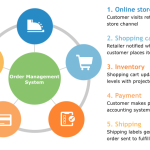Like a bad neighbor, your product’s not there
An order goes through a perilous adventure as it journeys to a customer. It travels through supplier channels, shipping carriers, and is placed in multiple hands before it arrives at its destination. Once it makes it, the package sits by a doorstep of an apartment exposed, alone, and hiding a purchased good inside. Anybody walking by surely thinks, “I could take that if I wanted to.” Just like that, an innocent product is snatched from its destiny, forced to endure a life where it doesn’t belong.
Nothing guarantees that your beloved order will make it into the warmth of a customer’s home, but there’s something called shipping insurance that helps.
Is your order in good hands?
Obviously, orders are a cost on the merchant’s end, with margins depending on a successful arrival. But there’s always a chance they either won’t get there at all, or they’ll show up beaten and bruised due to a mishandling as they hop around during the fulfillment process. Fortunately, shipping insurance exists to ensure you get your money back; it’s like life and health insurance for your goods.
Living up to its second word, shipping insurance is filled with somewhat confusing caveats and exceptions depending on a myriad of details. Fortunately, most major shipping carriers are relatively similar in terms of their coverage. Below are some general descriptions of what you can expect by provider (as of this date):
USPS separates its insurance based on how the order is shipped – whether it’s Priority Mail Express (fast) or Priority Mail (a little less fast). If the order’s value is $100 or less on your end, you’re guaranteed $100 worth of coverage when shipping through Priority Mail Express, and $50 for Priority Mail.
For orders greater than $100 that you want coverage on, USPS charges based on the value of your order. Take a look at this USPS shipping insurance chart for more information on fees by order value.
FedEx is slightly simpler than USPS. They prefer not to tamper with insurance at all, but do offer up to $100 worth of coverage for any damaged or lost shipment (like USPS). Instead of insurance, they focus on what’s called declared liability – if the value of an order is above $100, write in on the shipping label, pay a fee, and FedEx reimburses you if something goes wrong. Their rate is 90 cents per $100, but there’s a minimum fee of $2.70.
UPS is in the same boat as FedEx – up to $100 reimbursement on shipments with no declared value. When the order value enters the triple digits, declared value determines the shipping insurance fees, and they’re exactly the same as FedEx.
Please note that the above information is broad to an extent, and each carrier has their own rules with exceptions and qualifications regarding coverage and liability. Click each subhead to view their sites for specifics.
Pieces of mind
Let’s say your darkest fears come true, and your orders are confirmed to be lost. Now it’s time to piece together all documentation on them for a claim. You will need any proof you have to justify your claim: pictures of the product before it left, where it was shipped from, it’s destination, as well as proof of insurance and order value. Occasionally, a product isn’t lost, but arrives damaged or incomplete instead. The claims process is pretty much the same. Simply provide proof of the damage or loss of contents when filing a claim. The carriers can be a little slow in getting back to you.
Although it’s typically worth the added fees, handling your shipping insurance is about as annoying as Flo from the Progressive commercials. But if you just aren’t a fan of dealing with shipping insurance at all, options like Shipsurance exist to do it for you. They’re partnered with us, and provide discounted shipping insurance coverage along with claims processing so you can focus on sexier parts of your business, rather than grinding through backoffice chores.



